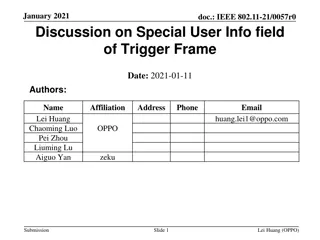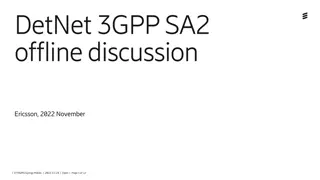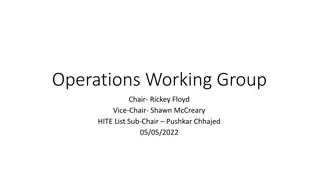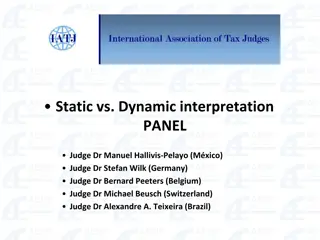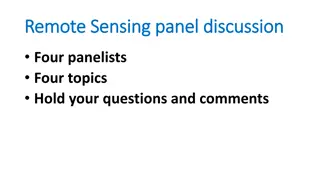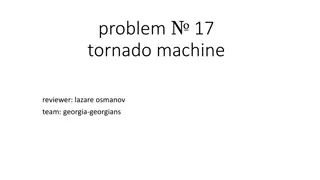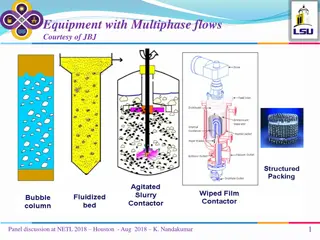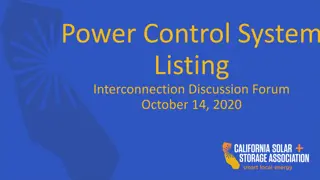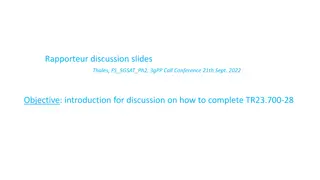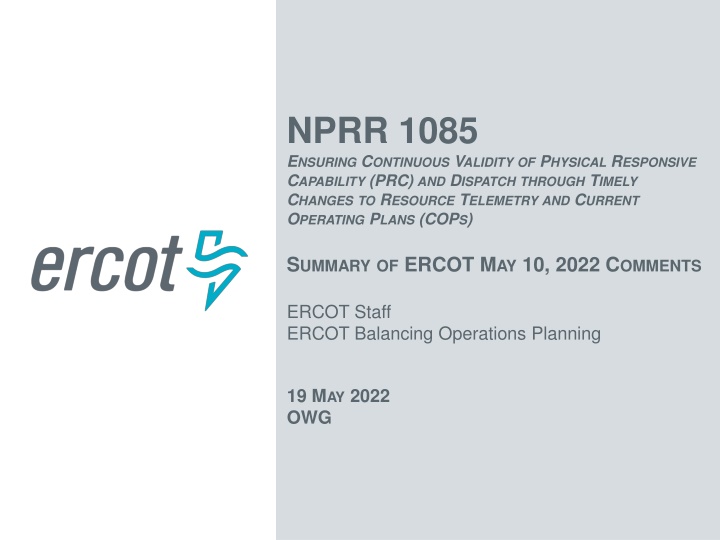
Continuous Validity of Physical Responsive Capability and Dispatch Updates
Ensure the continuous validity of Physical Responsive Capability (PRC) and dispatch through timely changes to resource telemetry and current operating plans. ERCOT's May 10, 2022, comments focus on streamlining processes for real-time operational needs and handling multiple resource issues effectively. The proposal aims to balance efficient updates with rare circumstances requiring extended timeframes, promoting operational reliability.
Download Presentation

Please find below an Image/Link to download the presentation.
The content on the website is provided AS IS for your information and personal use only. It may not be sold, licensed, or shared on other websites without obtaining consent from the author. If you encounter any issues during the download, it is possible that the publisher has removed the file from their server.
You are allowed to download the files provided on this website for personal or commercial use, subject to the condition that they are used lawfully. All files are the property of their respective owners.
The content on the website is provided AS IS for your information and personal use only. It may not be sold, licensed, or shared on other websites without obtaining consent from the author.
E N D
Presentation Transcript
NPRR 1085 ENSURING CONTINUOUS VALIDITY OF PHYSICAL RESPONSIVE CAPABILITY (PRC) AND DISPATCH THROUGH TIMELY CHANGES TO RESOURCE TELEMETRY AND CURRENT OPERATING PLANS (COPS) SUMMARY OF ERCOT MAY 10, 2022 COMMENTS ERCOT Staff ERCOT Balancing Operations Planning 19 MAY 2022 OWG
OUTLINE Summary of ERCOT s May 10, 2022 Comments What-If Analysis on Physical Responsive Capacity (PRC) for Feb 15, 2021 Examples of impact of erroneous telemetry on operations 2
NPRR1085 May 10, 2022 ERCOT Comment Summary Recognizing that QSEs may have to make several concurrent updates, which could present a challenge in meeting the originally proposed timelines, ERCOT s comments propose to balance ERCOT s real time operational needs and the rare circumstances where multiple, simultaneous Resource issues justify taking additional time to provide this information to ERCOT. Specifically, Resource Status (RST) telemetry changes for Forced Outages must be made as soon as practicable but no longer than 10 minutes after the event; Any other RST change must be made as soon as practicable but no longer than 15 minutes after the change in status; New RST ONHOLD may be used in Real Time to inform ERCOT that a Resource is On-Line but temporarily unavailable for SCED Dispatch or reserve provision. QSE may switch to ONHOLD within 10 minutes of experiencing an event; Telemetry changes related to a Forced Derate, must occur as soon as practicable but no longer than 15 minutes after a) the beginning of the forced derate if the derate is greater than ten MW and more than 5% of the Seasonal net max sustainable rating of the Resource and its expected or actual duration is greater than 30 minutes. OR b) Changing RST to ONHOLD Current Operating Plan (COP) updates including updates for Forced Outages and Forced Derates that are greater than 10 MW and expected to last more than 120 minutes, must be made as soon as practicable but no longer than 60 minutes after the triggering event for the change. 3 PUBLIC 3
ERCOT Notes The proposal to require RST telemetry updates for Forced Outages and ONHOLD status changes within 10 minutes of an event should not place Resource owners or QSEs in a position of having to choose between ensuring safety or plant or personnel or violating a Protocol, as these circumstances can be either automated to minimize human interaction or prioritized over Forced Derates, which allow for 15 minutes instead of 10 minutes. Forced Outages are less frequent than Forced Derates and are more impactful which aligns with the higher priority over a Forced Derate. Lastly, PUC Rule 25.503 (f)(2)(c) provides excusal from compliance with ERCOT Protocols if compliance would jeopardize public health and safety or risk of damage to equipment. PUC Rule 25.503. Oversight of Wholesale Market Participants. (f) Duties of market entities. (1) A market participant must comply with ERCOT procedures and any official interpretation of the Protocols issued by ERCOT or the commission. A. If a market participant disagrees with any provision of the Protocols or any official interpretation of the Protocols, it may seek an amendment of the Protocols as provided for in the Protocols, appeal an ERCOT official interpretation to the commission, or both. B. A market participant appealing an official interpretation of the Protocols or seeking an amendment to the Protocols must comply with the Protocols unless and until the interpretation is officially changed or the amendment is officially adopted. C. A market participant may be excused from compliance with ERCOT instructions or Protocol requirements only if such non-compliance is due to communication or equipment failure beyond the reasonable control of the market participant; if compliance would jeopardize public health and safety or the reliability of the ERCOT transmission grid, or create risk of bodily harm or damage to the equipment; if compliance would be inconsistent with facility licensing, environmental, or legal requirements; if required by applicable law; or for other good cause. A market participant is excused under this subparagraph only for so long as the condition continues. 4 PUBLIC 4
What if on Feb 15, 2021 timely updates were sent? Recap: ERCOT s analysis of the timeframe between 1:23 and 1:55 on Feb 15, 2021 had noted that out of 20 Generation Resources that were on an average contributing more than 10 MW to ERCOT s Physical Responsive Capacity (PRC), 14 resources had incorrect telemetry that resulted in approximately 430 MW to 870 MW in PRC that were incorrect/unavailable during that time. Methodology: To recreate PRC for the early morning hours on Feb 15, 2021, the following two steps were taken 1. PRC contribution from each of the 14 resources that were identified as having operational issues early morning of February 15, 2021 was set to 0 MW X minutes after an event occurred. X was set to 1min, 5min, 8min, 10min, 15min and 30min. 2. PRC from NCLRs providing RRS-UFR was set to 0 MW 12 minutes after updated PRC in each scenario reached 1,750 MW. During the February Winter storm event more than 95% of the response occurred within 8 minutes of NCLR RRS deployment. A 4-min delay was included to account for Operator action. 5 PUBLIC 5
What-If analysis for PRC based on timing of telemetry updates PRC Level Actual 1 Min Delay 5 Min Delay 8 Min Delay 10 Min Delay 15 Min Delay 30 Min Delay 02/15 00:24 (-59min) 02/15 00:24 (-59min) 02/15 00:24 (-59min) 02/15 00:24 (-59min) 02/15 00:37 (-46min) 02/15 00:42 (-41min) 1000 MW 02/15 01:23 6 PUBLIC 6
So, what if on Feb 15, 2021 timely telemetry updates were sent? Summary potential impact of timely telemetry updates on PRC on Feb 15, 2021 between 1:23 and 1:55. PRC Level Actual 1min Delay 5min Delay 8 Min Delay 10 Min Delay 15 Min Delay 30 Min Delay Minimum PRC (MW) 813 272 272 324 324 324 324 02/15 00:01 (-9min) 02/15 00:12 (-53min) 02/15 00:24 (-59min) 02/15 00:01 (-9min) 02/15 00:12 (-53min) 02/15 00:24 (-59min) 02/15 00:01 (-9min) 02/15 00:12 (-53min) 02/15 00:24 (-59min) 02/15 00:01 (-9min) 02/15 00:12 (-53min) 02/15 00:24 (-59min) 02/15 00:06 (-4min) 02/15 00:25 (-40min) 02/15 00:37 (-46min) 02/15 00:10 (0 min) 02/15 00:30 (-35min) 02/15 00:42 (-41min) 2300 MW 02/15 00:10 1750 MW 02/15 01:05 1000 MW 02/15 01:23 As Resources started experiencing winter weather related equipment failures, if telemetry updates had been made within ten minutes of an event occurring, calculated PRC would have reached 1,000 MW approximately 59 minutes earlier, giving Operators more appropriate situational awareness and time to make critical decisions and give instructions, including those related to Load shed. 7 PUBLIC 7
Example: Impact of incorrect telemetry on PRC Issue: A resource that was operating close to its HSL started experiencing issues, while telemetering an ON status its MW output declined to 0 MW over the course of 25 minutes. As the resource s output decreased its contribution to PRC increased but the unit really had no ability to respond to frequency or BPs. With NPRR1085: When a resource is experiencing a runback type event or an operator is manually controlling it, setting its RST to ONHOLD will ensure ERCOT s tools do not count on the resource for SCED dispatch or for provision of reserves. 8 PUBLIC 8
Example: Impact of incorrect telemetry on frequency recovery Issue: A group of 3 IRR units tripped offline causing frequency to drop to 59.926 Hz. MW telemetry of one of the units dropped to 0 MW and RST telemetry changed to OFF immediately following the event. However, the MW telemetry on the other two units remained a non-zero value up to 10 minutes after the start of the event and the RST telemetry for the units stayed ON up to 15 minutes after the event. Frequency took almost 9 minutes and 36 seconds to recover to pre disturbance value. A combination of regulation deployment, reduction in load and SCED redispatch were relied upon to recover frequency during this event. Frequency MW RST Breaker Status BP SCED Run Regulation Deployment With NPRR 1085: The focus of NPRR1085 is to promote the use of automation at resource s end to detect events like forced outages and use it to update the resource s RST to an offline status in a timely manner. 9 PUBLIC 9
APPENDIX PUBLIC 10
Physically Responsive Capacity (PRC) PRC is a representation of the total amount of frequency responsive Resource capability On- Line in Real-Time. Per Nodal Protocol Section 6.5.7.5, PRC is the sum of 7 components PRC = PRC1 + PRC2 + PRC3 + PRC4 + PRC5 + PRC6 + PRC7 PRC1: maximum of 20% of an On-Line Generation Resource s frequency responsive headroom. PRC2: maximum of 20% of an On-Line Wind Generation Resource s (WGR) headroom. Only WGRs with PFR capability are included. PRC from Generation PRC from Hydro PRC3: hydro-synchronous condenser headroom PRC4: RRS supplied from Load Resources controlled by high-set under-frequency relay PRC5: capacity from Controllable Load Resources active in SCED and carrying Ancillary Service Resource Responsibility PRC6: capacity from Controllable Load Resources active in SCED and carrying Ancillary Service Resource Responsibility PRC from Load Resource PRC7: capacity from Resources providing FFR 11 PUBLIC 11







